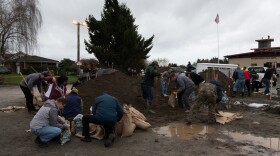Washington has devoted state lands to projects for solar and wind power. Now for the first time it will lease public timber lands as carbon sinks – preserving older forests to absorb greenhouse gas emissions and fight climate change. It will use carbon markets to generate income from stands of timber by not cutting them down
The Department of Natural Resources will sell leases on 10,000 acres of its most ecologically-valuable forests in Western Washington. Most of those are mature stands that were slated to be cut. Instead, an outside party will account for the carbon they absorb and sell credits to companies seeking offsets. Caitlin Guthrie is with Finite Carbon, which will act as the offset broker.
“By measuring the project over time, we will ensure the carbon offsets generated are not just estimates, but verifiable emissions reductions," Guthrie said at a public event in the Capitol State Forest near Olympia.
State Commissioner of Public Lands Hilary Franz announced the project at that event on Wednesday, April 6 calling it a first of its kind.
“The carbon project we are unveiling today will protect ten thousand acres of western Washington's most ecologically valuable forests and using carbon markets, generate tens of millions of dollars for the schools and critical local services like libraries and hospitals that our state trust land support," she said.
Franz says in the first ten years alone, the project will generate more than 900,000 carbon offset credits – which is equivalent to preventing more than two billion miles driven by gas powered cars.
DNR says the income this generates will be equivalent to timber revenues and will continue to help fund schools and other local services such as hospitals and libraries. The agency says this will serve as a national model.
But critics worry the revenue from the sales of carbon offsets won’t fully cover the agency's obligations. They say the 10,000 acres is only about 0.5% of all of the state’s forested trust lands and that the agency is still cutting older stands.
The Seattle Times reports the carbon credit purchasers are expected to be larger corporations seeking to achieve reductions in their carbon emissions.
In addition to the 840,000 acres of DNR-managed trust land designated for conservation, the 10,000-acre carbon reserve adds a bit more acreage off-limits to harvest. But as climate change threatens the planet, these trees are more valuable living than as lumber, Franz said.
Sequestering carbon dioxide, a heat-trapping gas, in trees which use it as food to grow, helps blunt the worst effects of climate change. Globally, forests absorb about a third of all the carbon emissions annually from the burning of fossil fuels.

“I have a big belief that with climate change here, we need to save our forests to truly save ourselves,” Franz said.
The DNR has come under increasing criticism for harvesting such trees, which are not protected under its old-growth policy but nonetheless have high ecological value.
A total of 3,750 acres are being set aside now, with the remaining balance to be identified for preservation in a second phase.
The program in Washington is launching with protection of forests in Whatcom, Thurston, King and Grays Harbor counties.
DNR trust lands generate about $180 million a year for schools and counties across the state.
Franz predicted the carbon leases would generate tens of millions of dollars for schools, colleges and local services that state trust lands support.
Peter Goldman, director and managing attorney of the nonprofit Washington Forest Law Center, called the reserve “green lipstick on a pig” because it sets some state lands aside for conservation while other state legacy forests are still being cut down.
“It’s great, who could be against it,” he said of the reserve. “But is she just trying to pour cold water on the political heat she is taking on these sales?”






